List of lunar deities
In mythology, a lunar deity is a god or goddess of the Moon, sometimes as a personification. These deities can have a variety of functions and traditions depending upon the culture, but they are often related. Some form of Moon worship can be found in most ancient religions.
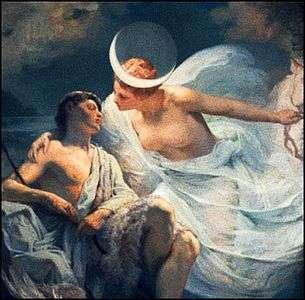
Moon in religion and mythology
The monthly cycle of the Moon, in contrast to the annual cycle of the Sun's path, has been implicitly linked to women's menstrual cycles by many cultures, as evident in the links between the words for menstruation and for Moon in many resultant languages,[1] though this identification was not universal as demonstrated by the fact that not all moon deities are female. Many well-known mythologies feature female lunar deities, such as the Greek goddess Selene, the Roman goddess Luna, and the Chinese goddess Chang'e.
Male lunar gods are also frequent, such as Sin of the Mesopotamians, Mani of the Germanic tribes, Tsukuyomi of the Japanese, and Igaluk/Alignak of the Inuit. The ancient Egyptians had several male moon gods, for example, Ibis and Khonsu of Thebes. Thoth was also a lunar deity, but his character is considerably more complex than Ibis and Khonsu.[2] Set represented the Moon in the Egyptian Calendar of Lucky and Unlucky Days of papyrus Cairo 86637.[3] These cultures usually feature female sun goddesses. An exception is Hinduism; featuring both male and female aspects of the solar divine.
The original Proto-Indo-European lunar deity appears to have been male.[4] Several goddesses, like Artemis or Hecate, did not originally have lunar aspects, and only acquired them late in antiquity, due to syncretism with Selene/Luna, the de facto Greco-Roman lunar deity. In traditions with male gods, there is little evidence of such syncretism, though the Greek Hermes has been equated with the male Egyptian lunar god Thoth. In Greece proper, remnants of male moon gods are also seen with Menelaus. Nyx is the goddess of night.
Also of significance is that many religions and societies are oriented chronologically by the Moon, as opposed to the Sun. One common example is Hinduism in which the word Chandra means "Moon" and has religious significance during many Hindu festivals (e.g. Karwa Chauth, Sankasht Chaturthi, and during eclipses). The ancient Germanic tribes were also known to have a lunar calendar.
The Moon features prominently in art and literature and also has a purported influence in human affairs, a belief that consistently remains a feature of astrology, though beliefs such as this are classified as pseudoscience.
List of moon deities
African
| Name | Image | Mythology / Religion | Details |
|---|---|---|---|
| Abuk | Dinka | Goddess of fertility, morality, creativity and love | |
| Ala | Igbo | Goddess of fertility, morality and creativity | |
| Gleti | Dahomean | ||
| Mawu | Dahomean | ||
| Iah | Egyptian | ||
| iNyanga | Zulu | Goddess of the Moon | |
| Khonsu | Egyptian | The god of the moon. Khonsu grew an addiction to gambling. Once, while he was gambling he lost five days of moonlight to Nut (the goddess of the sky) in a game of senet, which allowed time for Nut to give birth to her five children. Sometimes, Khonsu is depicted as a hawk-headed god, however he is mostly depicted as a young man with a side-lock of hair, like a young Egyptian. He was also a god of time. The centre of his cult was at Thebes which was where he took place in a triad with Amun and Mut. Khonsu was also heavily associated Thoth who also took part in the measurement of time and the moon. | |
| Thoth | Egyptian | God of wisdom, the arts, science, and judgment | |
| Ela-Opitan | Yoruba | ||
Europe
| Name | Image | Mythology / Religion | Details |
|---|---|---|---|
| Arianrhod | Welsh | ||
| Artemis |  |
Greek | Artemis is the ancient Greek goddess of the hunt, wilderness, wild animals, chastity, and the Moon.[5][6] She is the daughter of Zeus and Leto and the twin sister of Apollo.[7] She would eventually be extensively syncretized with the Roman goddess Diana. Cynthia was originally an epithet of the Greek goddess Artemis, who according to legend was born on Mount Cynthus. Selene, the Greek personification of the moon, and the Roman Diana were also sometimes called "Cynthia".[8] |
| Artume | Etruscan | ||
| Ataegina | 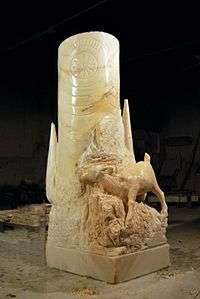 |
Lusitanian | |
| Bendis | 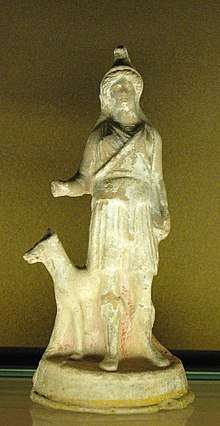 |
Thracian | |
| Cynthia | Greek and Roman | Cynthia was originally an epithet of the Greek goddess Artemis, who according to legend was born on Mount Cynthus. Selene, the Greek personification of the moon, and the Roman Diana were also sometimes called "Cynthia".[9] | |
| Diana | 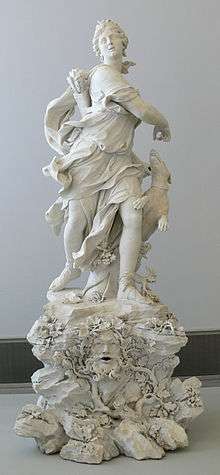 |
Roman | |
| Elatha | Irish | Elatha was a king of the Fomorians in Irish mythology. He succeeded his father Delbáeth and was replaced by his son Bres, mothered by Ériu. | |
| Hecate | 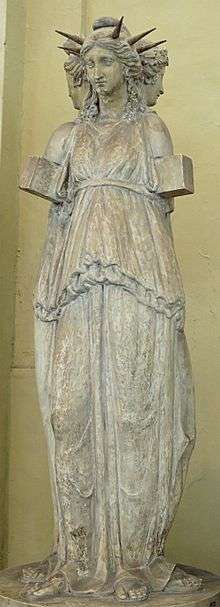 |
Greek | |
| Hors | Slavic | ||
| Hjúki and Bil | Norse | ||
| Ilargi | Basque | ||
| Kuu | Finnish | ||
| Losna | Etruscan | ||
| Luna | 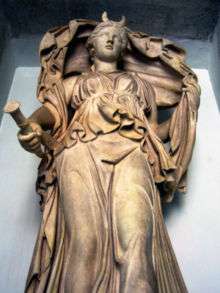 |
Roman | |
| Mano | Sámi | ||
| Máni | 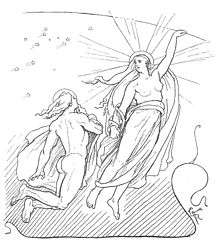 |
Norse | |
| Meness | Latvian | ||
| Phoebe | Greek | ||
| Selene | 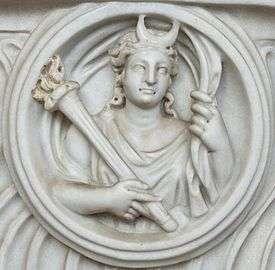 |
Greek | |
| Triple Goddess |  |
Wicca | |
Asia
Ainu mythology
- God Kunnechup Kamui
Chinese mythology
- Jie Lin, God that carries the Moon across the night sky [10]
- Chang Xi Mother of twelve moons corresponding to the twelve months of the year
- Chang'e Immortal that lives on the Moon
- Tai yin xing jun (太陰星君 Tàiyīn xīng jūn ) of Investiture of the Gods in taoism and Chinese folk religion[11][12][12]
- Tu'er Ye Rabbit god that lives on the Moon
- Wu Gang Immortal that lives on the Moon
Elamite
- God Napir
Hindu Mythology
- God Chandra or Soma, The moon god
Indonesian mythology
- Goddess Ratih
- Goddess Silewe Nazarate
Korean mythology
- Goddess Myeongwol
Mari mythology
- God Tõlze
Philippine mythology
- Visayan god Bulan/Libulan
- God/Goddess Mayari (gender depends on tribe)
Semitic mythology
Austronesian
- God Andriambahomanana (Malagasy mythology)
- Goddess Lona (Hawaiian mythology)
- God Avatea (Polynesian mythology)
- God Fati (Polynesian mythology)
- Goddess Hina (Polynesian mythology)
- Goddess Mahina (Polynesian mythology)
- God Marama (Polynesian mythology)
Australia
Americas
Aztec mythology
- Goddess Coyolxauhqui
- Goddess Metztli
- God Tecciztecatl (see Metztli)
Cahuilla mythology
- Goddess Menily
Hopi mythology
- God Muuya
Incan mythology
- Goddess Mama Killa
- Goddess Ka-Ata-Killa
- God Coniraya
Inuit mythology
- God Alignak
- God Igaluk
- God Tarqiup Inua
Lakota mythology
- Goddess Hanwi
Maya mythology
- Goddess Awilix; Xbalanque was her mortal (male) incarnation
- Maya moon goddess
Pawnee mythology
- God Pah
Tupi Guarani mythology
- God Abaangui
- Goddess Arasy
- God/Goddess Jasy (gender depends on tribe)
Voodoo
- God Kalfu
See also
References
- Harding, Esther M., 'Woman's Mysteries: Ancient and Modern', London: Rider, 1971, p. 24.
- Thoth, the Hermes of Egypt: a study of some aspects of theological thought in ancient Egypt, page 75
- Jetsu, L.; Porceddu, S. (2015). "Shifting Milestones of Natural Sciences: The Ancient Egyptian Discovery of Algol's Period Confirmed". PLOS ONE. 10 (12): e.0144140 (23pp). arXiv:1601.06990. Bibcode:2015PLoSO..1044140J. doi:10.1371/journal.pone.0144140. PMC 4683080. PMID 26679699.
- Dexter, Miriam Robbins. Proto-Indo-European Sun Maidens and Gods of the Moon. Mankind Quarterly 25:1 & 2 (Fall/Winter, 1984), pp. 137–144.
- Shen (2018), p. 60
- Sacks (1995), p. 35
- Neils (2003), p. 117
- Pannen, p. 96.
- Pannen, p. 96.
- 太上洞真五星秘授经
- Overmyer (1986), p. 51.
- Fan, Chen 2013. p. 23
Bibliography
- Neils, Jennifer; Oakley, John H. (August 11, 2003). Coming of Age in Ancient Greece: Images of Childhood from the Classical Past. Hanover, New Hampshire, United States: Hood Museum of Art. ISBN 978-0300099591.
- Rees, Alwyn; Rees, Brinley (1961). Celtic Heritage: Ancient Tradition in Ireland and Wales. High Holborn, London, England: Thames & Hudson. Retrieved August 14, 2019.
- Sacks, David (January 1, 1995). Murray, Oswyn (ed.). A Dictionary of the Ancient Greek World. Oxford, England, United Kingdom: Oxford University Press. ISBN 978-0195112061.
- Shen, Ann (April 3, 2018). Legendary Ladies: 50 Goddesses to Empower and Inspire You. San Francisco, United States: Chronicle Books. ISBN 978-1452163413. Retrieved August 14, 2019.
External links
| Wikimedia Commons has media related to Lunar deities. |
